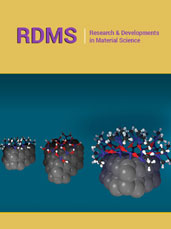- Submissions

Full Text
Modern Research in Dentistry
The Expanding Role of Artificial Intelligence in Modern Dentistry
Omid Panahi1* and Masoumeh Jabbarzadeh2
1Department of Healthcare Management, University of the People, USA
2School of Dentistry, Iran
*Corresponding author: Omid Panahi, Department of Healthcare Management, University of the People, California, USA
Submission: January 04, 2025;Published: February 12, 2025

ISSN:2637-7764Volume8 Issue2
Abstract
Artificial Intelligence (AI) is rapidly transforming various sectors, and dentistry is no exception. This paper explores the expanding role of AI in modern dental practice, examining its applications in diagnosis, treatment planning, and patient care. AI-powered tools are being developed to assist in the detection of dental caries, periodontal disease, and oral cancer through the analysis of radiographic images and clinical data. Furthermore, AI [1,2] algorithms are being utilized to create personalized treatment plans, predict treatment outcomes, and automate certain dental procedures. While challenges remain in terms of data privacy, algorithm bias, and regulatory frameworks, the integration of AI has the potential to enhance diagnostic accuracy, improve treatment efficiency, and ultimately elevate the standard of dental care. This paper provides an overview of the current state of AI in dentistry, discusses its potential benefits and limitations, and highlights future directions for research and development.
Keywords:Artificial intelligence; Dentistry; Diagnosis; Treatment planning; Patient care; Machine learning; Deep learning; Oral health
Introduction
Artificial Intelligence (AI) is no longer a futuristic concept confined to science fiction; it is a tangible force reshaping industries across the globe, and dentistry is undergoing a profound transformation under its influence. This technology, encompassing machine learning and deep learning algorithms, empowers computers to analyze vast datasets, recognize patterns, and make informed decisions-capabilities with far-reaching implications for dental practice. This paper delves into the burgeoning role of AI in modern dentistry, exploring its current applications, potential benefits, and the challenges that lie ahead.
Traditionally, dentistry has relied heavily on the clinician’s expertise and subjective interpretation of clinical and radiographic findings. However, the advent of AI [3-5] introduces a new paradigm, one where intelligent system augment the dentist’s capabilities, offering objective assessments, personalized treatment plans, and even the automation of certain procedures. Imagine AI algorithms sifting through radiographic images, detecting subtle caries lesions or periodontal bone loss that might elude the human eye, or predicting the longterm success of implant placement based on patient-specific factors. This is the promise of AI in dentistry - to enhance diagnostic accuracy, improve treatment efficiency, and ultimately optimize patient outcomes.
AI in Diagnosis: A New Era of Precision
One of the most significant contributions of AI in dentistry lies in its potential to revolutionize diagnostics. AI-powered tools are being developed to analyze diverse data sources, including radiographic images, intraoral photographs [6-9], and patient records, to assist in the detection of a wide range of dental conditions. These range from caries and periodontal disease to oral cancer and temporomandibular disorders. By recognizing intricate patterns and subtle anomalies, AI algorithms can identify early signs of disease, enabling timely intervention and potentially preventing more severe complications.
For instance, AI algorithms trained on vast datasets of radiographs can detect carious lesions with remarkable accuracy, even in their incipient stages. This not only aids early diagnosis but also facilitates minimally invasive treatment interventions. Similarly, AI-powered systems can analyze periodontal probing depths and radiographic bone levels to assess the severity of periodontal disease and predict its progression. This enables dentists to tailor treatment plans to individual patient needs and monitor their response to therapy more effectively.
AI in Treatment Planning: Personalized and Predictive
Beyond diagnostics, AI is poised to transform treatment planning into dentistry. By analyzing patient-specific data, AI algorithms can generate personalized treatment recommendations, predict treatment outcomes, and even guide surgical procedures. This not only enhances the precision and efficiency of dental care but also empowers patients to make informed decisions about their oral health.
In orthodontics, AI algorithms can analyze cephalometric radiographs and intraoral scans to predict tooth movement and treatment outcomes, assisting in the selection of optimal appliances and treatment modalities. In implantology, AI [10-12] can assess bone quality and quantity from CBCT scans, aiding in implant placement and predicting long-term implant success. Even in restorative dentistry, AI can analyze tooth morphology and occlusal relationships to design optimal restorations and predict their longevity.
AI in Patient Care: Enhancing Efficiency and Communication
The impact of AI extends beyond the clinical aspects of dentistry, influencing patient care and communication as well. AI-powered chatbots can answer patient queries, schedule appointments, and provide post-operative instructions, freeing up valuable staff time and enhancing patient satisfaction. Furthermore, AI can analyze patient data to identify individuals at high risk of developing dental diseases, enabling targeted preventive interventions and personalized oral health education.
Challenges and Future Directions
While the potential of AI in dentistry is vast, it is essential to acknowledge the challenges that accompany its integration. Data privacy and security are paramount concerns, as AI algorithms rely on access to sensitive patient information. Ensuring fairness and mitigating bias in AI algorithms is crucial to prevent disparities in dental care. Furthermore, establishing clear regulatory frameworks and ethical guidelines will be essential to ensure the responsible and equitable implementation of AI in dental practice [13-16].
Challenges and Benefits of AI in Modern Dentistry
The integration of Artificial Intelligence (AI) into modern dentistry presents a wealth of opportunities to enhance patient care and practice efficiency. However, it also brings forth a unique set of challenges that must be addressed to ensure its responsible and effective implementation.
Benefits of AI in Dentistry
Enhanced diagnostic accuracy
AI algorithms can analyze radiographic images, clinical photographs, and patient data with a level of precision that can surpass human capabilities. This leads to earlier and more accurate detection of dental caries, periodontal disease, oral cancer, and other conditions.
Improved treatment planning
AI can generate personalized treatment plans based on patientspecific data, predict treatment outcomes, and even guide surgical procedures. This results in more efficient and effective treatments, tailored to individual needs.
Increased efficiency and productivity
AI can automate administrative tasks such as appointment scheduling, patient communication, and billing, freeing up staff time and allowing dentists to focus on patient care.
Enhanced patient experience
AI-powered chatbots can answer patient queries, provide postoperative instructions, and offer personalized oral health education, improving patient satisfaction and adherence to treatment plans.
Predictive analytics
AI algorithms can analyze patient data to identify individuals at high risk of developing dental diseases, enabling targeted preventive interventions and personalized oral health education.
Continuous learning and improvement
AI systems can continuously learn and improve their performance as they are exposed to more data, leading to ongoing advancements in diagnostic accuracy and treatment effectiveness.
Challenges of AI in Dentistry
Data privacy and security
AI algorithms rely on access to sensitive patient information, raising concerns about data privacy and security. Robust data protection measures and compliance with relevant regulations are essential.
Algorithm bias
AI algorithms are trained on data, and if that data reflects existing biases, the algorithms may perpetuate or even amplify those biases. Ensuring fairness and mitigating bias in AI algorithms is crucial to prevent disparities in dental care.
Regulatory frameworks
Clear regulatory frameworks and ethical guidelines are needed to govern the development, validation, and deployment of AI technologies in dentistry.
Cost of implementation
Implementing AI technologies can be expensive, requiring investments in hardware, software, and training. This can be a barrier for some dental practices, particularly smaller ones.
Lack of standardization
There is a lack of standardization in data formats and AI algorithms in dentistry, which can hinder interoperability and data sharing.
Need for human oversight
While AI [17] can augment the capabilities of dentists, it cannot replace them entirely. Human oversight and clinical judgment remain essential to ensure appropriate patient care.
Ethical considerations
Ethical considerations related to AI decision-making, accountability, and transparency need to be addressed to ensure responsible and ethical use of AI in dentistry.
Results
Enhanced diagnostic accuracy
Caries detection: Studies have shown that AI algorithms can detect caries on radiographs with sensitivity and specificity comparable to or even exceeding that of experienced dentists. This leads to earlier detection of lesions and more conservative treatment approaches.
Periodontal disease assessment: AI [18] can accurately measure bone loss and assess periodontal disease severity from radiographs and clinical data, aiding in diagnosis and treatment planning.
Oral cancer detection: AI systems have demonstrated promising results in detecting oral cancer from images, potentially improving early diagnosis and patient outcomes.
Improved treatment planning
Orthodontics: AI can predict tooth movement during orthodontic treatment with reasonable accuracy, assisting in treatment planning and appliance selection.
Implantology: AI can analyze CBCT scans to assess bone quality and quantity, aiding in implant placement planning and predicting implant stability.
Restorative dentistry: AI can assist in designing dental restorations with improved accuracy and efficiency, potentially leading to better fit and longevity.
Increased efficiency and productivity
Automated tasks: AI-powered systems can automate tasks such as appointment scheduling, patient communication, and billing, freeing up staff time and improving practice efficiency.
Reduced treatment time: AI-assisted treatment planning and procedures can potentially reduce treatment time, and the number of appointments required.
Enhanced patient experience
Improved communication: AI-powered chatbots can provide patients with quick and accurate answers to their questions, improving communication and satisfaction.
Personalized care: AI can enable personalized treatment plans and preventive strategies based on individual patient needs and risk factors.
Examples of AI in Action
A. Diagnocat: An AI-powered software that analyzes dental
X-rays to detect dental diseases like caries, periodontitis, and
periapical lesions.
B. Dental Mind: An AI platform that assists in orthodontic
treatment planning by analyzing cephalometric radiographs
and predicting tooth movement.
C. Numerous AI-driven intraoral scanners and CAD/CAM
systems: These systems use AI to optimize the design and
fabrication of dental restorations.
Future Works
Future work in the field of AI in dentistry should focus on several key areas to maximize its potential and address existing limitations:
Expanding data sets and improving algorithm training
Larger and more diverse data sets: Training AI [19] algorithms on larger and more diverse data sets is crucial to improve their accuracy, generalizability, and robustness. This includes data from various populations, ethnicities, and age groups.
Multi-modal data integration: Integrating data from multiple sources, such as radiographs, clinical photographs, patient records, and genomic data, can provide a more comprehensive view of the patient and improve diagnostic and treatment planning accuracy.
Federated learning: Exploring federated learning approaches, which allow AI models to be trained on decentralized data sets without sharing sensitive patient information, can address data privacy concerns.
Enhancing AI Capabilities
Explainable AI (XAI): Developing XAI techniques that provide insights into how AI algorithms make decisions can increase transparency and trust in AI systems.
AI for personalized medicine: Utilizing AI to develop personalized treatment plans and preventive strategies based on individual patient characteristics, risk factors, and preferences.
AI for early disease detection: Focusing on developing AI algorithms that can detect early signs of dental diseases, such as caries, periodontal disease, and oral cancer, to enable timely intervention and improve patient outcomes.
AI for patient education and engagement: Developing AIpowered tools that can educate patients about oral health, provide personalized oral hygiene instructions, and promote patient engagement in their care.
Addressing ethical and regulatory considerations
Developing ethical guidelines: Establishing clear ethical guidelines for the development and use of AI in dentistry, addressing issues such as data privacy, algorithm bias, and accountability.
Establishing regulatory frameworks: Creating regulatory frameworks for the validation, approval, and deployment of AI technologies in dentistry to ensure their safety and effectiveness.
Clinical implementation and evaluation
Conducting clinical trials: Conducting rigorous [20,21] clinical trials to evaluate the effectiveness and safety of AI applications in real-world dental settings.
Developing standardized evaluation metrics: Establishing standardized metrics for evaluating the performance of AI algorithms in dentistry to facilitate comparison and benchmarking.
Integrating AI into dental education: Incorporating AI into dental curricula to train future dentists on how to use and interpret AI-powered tools.
Interdisciplinary collaboration
Collaboration between dentists, AI researchers, and industry: Fostering collaboration between dentists, AI researchers, and industry [22] to accelerate the development and implementation of AI technologies in dentistry.
Conclusion
In conclusion, the integration of Artificial Intelligence (AI) into modern dentistry represents a paradigm shift with the potential to revolutionize various aspects of dental practice. From enhancing diagnostic accuracy and improving treatment planning to increasing efficiency and personalizing patient care, AI offers a wealth of opportunities to elevate the standard of oral health care. AI algorithms have demonstrated promising results in detecting dental caries, periodontal disease, and oral cancer from radiographic images and clinical data, often achieving levels of accuracy comparable to or even exceeding those of experienced clinicians. This allows for earlier diagnosis, minimally invasive interventions, and ultimately, better patient outcomes. Furthermore, AI-powered tools are being developed to generate personalized treatment plans, predict treatment outcomes, and even guide surgical procedures, leading to more efficient and effective treatments tailored to individual patient needs.
However, the implementation of AI in dentistry is not without its challenges. Concerns regarding data privacy and security, algorithm bias, regulatory frameworks, and the cost of implementation must be addressed to ensure responsible and equitable use of AI technologies. Ongoing research and development are crucial to refine AI algorithms, validate their effectiveness in real-world settings, and establish clear ethical guidelines and regulatory frameworks.
References
- Omid P (2024) Empowering dental public health: Leveraging artificial intelligence for improved oral healthcare access and outcomes. JOJ Pub Health 9(1): 555754.
- Panahi P, Bayılmış C (2017) Car indoor gas detection system. In 2017 International Conference on Computer Science and Engineering (UBMK), IEEE, pp. 957-960.
- Omid Panahi (2024) AI: A new frontier in oral and maxillofacial surgery. Acta Scientific Dental Sciences 8.6 (2024): 40-42.
- Omid Panahi (2024) Teledentistry: Expanding access to oral healthcare. Journal of Dental Science Research Reviews & Reports 6(3): 2-3.
- Omid Panahi (2024) Artificial intelligence: A new frontier in periodontology. Mod Res Dent 8(1). MRD. 000680. 2024.
- Omid Panahi (2024) AI ushering in a new era of digital dental-medicine. Acta Scientific Medical Sciences 8.8 (2024): 131-134.
- Panahi P (2010) The feedback-based mechanism for video streaming over multipath ad hoc networks. Journal of Sciences, Islamic Republic of Iran 21(2): 169-179.
- Omid Panahi, Mohammad Zeinalddin (2024) The remote monitoring toothbrush for early cavity detection using artificial intelligence (AI) International Journal of Dental Science and Innovative Research 7(4): 173-178.
- Panahi O, Zeinaldin M (2024) Digital dentistry: Revolutionizing dental care. J Dent App 10 (1): 1121.
- Panahi O (2024) AI in surgical robotics: Case studies. Austin J Clin Case Rep 11(7): 1342.
- Omid Panahi (2024) Dental implants & the rise of AI. On J Dent & Oral Health 8(1): 2024.
- Panahi O (2024) The rising tide: Artificial intelligence reshaping healthcare management. SJ Publc Hlth 1(1) :1-3.
- Panahi O, Zeinalddin M (2024) The convergence of precision medicine and dentistry: An AI and robotics perspective. Austin J Dent 11(2): 1186.
- Omid Panahi, Uras Panahi (2025) AI-powered IoT: Transforming diagnostics and treatment planning in oral implantology. J Adv Artif Intell Mach Learn 1(1): 1-4.
- Omid Panahi, Sevil Farrokh (2024) USAG-1-based therapies: A paradigm shift in dental medicine. Int J Nurs Health Care 1(1): 1-4.
- Omid Panahi, Sevil Farrokh (2024) Can AI heal us? The promise of ai-driven tissue engineering. Int J Nurs Health Care.
- Panahi O, Zeinaldin M (2024) AI-assisted detection of oral cancer: A comparative analysis. Austin J Pathol Lab Med 10 (1): 1037.
- Omid P, Reza S (2024) How artificial intelligence and biotechnology are transforming dentistry. Adv Biotech & Micro 18(2): 555981.
- Omid P (2024) Modern sinus lift techniques: Aided by AI. Glob J Oto 26(5): 556198.
- Panahi O (2024) Bridging the gap: AI-driven solutions for dental tissue regeneration. Austin J Dent11(2): 1185.
- Omid P (2024) Artificial intelligence in oral implantology, its applications, impact and challenges. Adv Dent & Oral Health 17(4): 555966.
- Omid Panahi, Reza Safaralizadeh (2024) AI and dental tissue engineering: A potential powerhouse for regeneration. Mod Res Dent 8(2): MRD. 000682.
© 2025 Omid Panahi. This is an open access article distributed under the terms of the Creative Commons Attribution License , which permits unrestricted use, distribution, and build upon your work non-commercially.
 a Creative Commons Attribution 4.0 International License. Based on a work at www.crimsonpublishers.com.
Best viewed in
a Creative Commons Attribution 4.0 International License. Based on a work at www.crimsonpublishers.com.
Best viewed in 







.jpg)






























 Editorial Board Registrations
Editorial Board Registrations Submit your Article
Submit your Article Refer a Friend
Refer a Friend Advertise With Us
Advertise With Us
.jpg)






.jpg)














.bmp)
.jpg)
.png)
.jpg)










.jpg)






.png)

.png)



.png)






